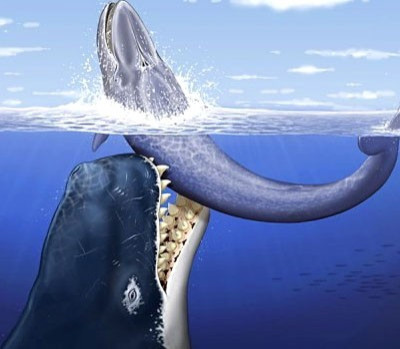Fossil of monster whale that ate whales for breakfast found

Scientists have discovered, journal Nature reported, fossils of an ancient monster whale that preyed on other whales. The beast has been named Leviathan Melvillei after the author of Moby Dick.
The monster whale grew up to 60 feet long, not unusual by today's standards. However, the fossils showed that the creature boasted of vicious, tusk-like teeth - some as long as 14 inches long.
According to the researchers, who discovered a skull of the beast in a Peruvian desert, the creature lived 13 million years ago and preyed and dined on other whales.
Paleontologist Olivier Lambert of the Natural History Museum in Paris, France, who led the team which found the fossil, said the giant 10 feet-long skull could be seen from very far.
The discovery, Lambert said, proved that Leviathan is not merely the stuff of myth and legend. It was a very exciting moment, he said.
Generally, present day sperm whales are known to live on giant squids but this monster specimen could have dined on something more, such as dolphins, seals, and even other whales, Lambert speculated. It was a super-predator, he said.
Dr Christian de Muizon, director of the Natural History Museum in Paris said it's possible that this massive creature and a giant shark that measured about 50 feet long and lived during the same time in the same waters, might have fought each other.
Anthony Friscia, a paleontologist at the University of California, Los Angeles, said the discovery is significant as this is the first time the entire jaw - well, almost the entire skull has been found. These whales, Friscia said, were close to the biggest things around. Friscia was involved in the discovery.
Compared to this beast, sperm whales have managed to survive till today because, being deep ocean feeders, they are much less vulnerable to climatic deterioration than surface-bound [active predators], said Jelle Reumer, a palaeontologist at the Natural History Museum of Rotterdam, Netherlands and coauthor on the study.
The fossil is now part of a collection at the Natural History Museum in Lima, Peru.
© Copyright IBTimes 2024. All rights reserved.





















